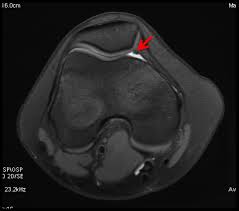The knee is a made up of a variety of complex soft tissues. Enclosing the knee joint is a fold at its membrane known as the plica. The knee is encapsulated�by a fluid-filled structure called the synovial membrane. Three of these capsules, known as the synovial plicae, develop around the knee joint throughout the fetal stage and are absorbed before birth.
However, during one research study in 2006, researchers found that 95 percent of patients undergoing arthroscopic surgery had remnants of their synovial plicae. Knee plica syndrome occurs when the plica becomes inflamed, generally due to sports injuries.�This often takes place in the center of the kneecap, known as medial patellar plica syndrome.
Contents
What are the Symptoms of Knee Plica Syndrome?
The most common symptom of knee plica syndrome is knee pain, although a variety of health issues can also cause these symptoms. Knee pain associated with knee plica syndrome is generally: achy, instead of sharp or shooting; and worse when using stairs, squatting, or bending. Other symptoms of knee plica syndrome can also include the following:�
- a catching or locking sensation on the�knee while getting up from a chair after sitting for an extended period of time,
- difficulty sitting for extended intervals,
- a cracking or clicking noise when bending or stretching the knee,
- a feeling that the knee is slowly giving out,
- a sense of instability on slopes and stairs,
- and may feel swollen plica when pushing on the knee cap.
What are the Causes of Knee Plica Syndrome?
Knee plica syndrome is commonly caused as�a result of an excess of stress or pressure being placed on the knee or due to overuse. This can be brought on by physical activities and exercises which require the individual to bend and extend the knee like running, biking, or utilizing a stair-climbing machine. An automobile accident injury or�a�slip-and-fall accident can also cause knee plica syndrome.

Knee plica syndrome, commonly referred to as medial patellar plica syndrome, is a health issue which occurs when the plica, a structure which surrounds the synovial capsule of the knee, becomes irritated and inflamed. Knee plica syndrome can occur due to sports injuries, automobile accident injuries, and slip-and-fall accidents, among other types of health issues. The symptoms of knee plica syndrome may commonly be mistaken for chondromalacia patella. Diagnostic imaging can help diagnose the problem to continue with treatment.
Dr. Alex Jimenez D.C., C.C.S.T. Insight
How is Knee Plica Syndrome Diagnosed?
In order to diagnose medial patellar plica syndrome, the healthcare professional will first perform a physical examination. They will use the evaluation to rule out any other potential causes of knee pain, such as a torn meniscus, tendonitis, and broken bones or fractures. Be sure to talk to your doctor about any physical activities you participate in along with any recent health issues. The healthcare professional might also utilize an X-ray or MRI to have a better look at your knee.
What is the Treatment for Knee Plica Syndrome?�
Most instances of medial patellar plica syndrome respond well to alternative treatment options, such as chiropractic care, physical therapy or even a physical activity or exercise plan at home. Chiropractic care uses spinal adjustments and manual manipulations to safely and effectively correct a variety of health issues associated with the musculoskeletal and nervous system. Moreover, chiropractic care and physical therapy can include a series of stretches and exercises to help restore strength, mobility, and flexibility to the hamstrings and quadriceps. These stretches and exercises are described below.
Quadriceps Strengthening
The medial plica is attached to the quadriceps, a major muscle on the thighs. An individual with weakened quadriceps has a higher chance of developing knee plica syndrome. You can strengthen your quadriceps by performing the stretches and exercises as follow:
- quadriceps sets or muscle tightening
- straight leg raises
- leg presses
- mini-squats
- biking, swimming, walking, or use an elliptical machine.
Hamstring Stretching
The hamstrings are the muscles which extend down the back of the thighs, from the pelvis to the shin bone. These help flex the knee. Tight hamstrings place more stress and pressure on the front of the knee, or the plica. A chiropractor or physical therapist will guide the patient through numerous stretches and exercises which may help unwind the nerves. As soon as the patient learns these moves, they may perform them a few times each day to keep the muscles relaxed.
Corticosteroid Injections
Some healthcare professionals may provide corticosteroid injections for the knee if the pain and inflammation causes a restriction in function. Corticosteroid injections can help temporarily reduce painful symptoms, however, it’s essential for the patient to continue with treatment to heal knee plica syndrome. The painful symptoms may return when the corticosteroid burns off if not treated.
Surgery
If chiropractic care, physical therapy, or the treatment described above does not help heal knee plica syndrome, a procedure known as arthroscopic resection may be needed. To perform this process, the doctor will insert a small camera, called an arthroscope, via a tiny cut at the side of the knee. Small surgical instruments are then inserted through a second small cut to take out the plica or correct its position.
After surgery, your doctor will consult with a chiropractor or physical therapist for a rehabilitation program.�Recovering from surgery for knee plica syndrome is dependent upon many factors, including the patient’s overall health and wellness. The patient may recover within a few days in case the knee has been changed. Remember to wair a few weeks before returning to a routine levels of exercise and physical activity.
Living with Knee Plica Syndrome
Plica syndrome is generally easy to treat with chiropractic care, physical therapy,�and other treatment approaches, as described above. Should you need surgery, the approach is minimally invasive and requires less recovery compared to a number of different types of knee surgery.
Talk to your healthcare professional to determine the best treatment choice for your knee plica syndrome. The scope of our information is limited to chiropractic and spinal health issues. To discuss the subject matter, please feel free to ask Dr. Jimenez or contact us at�915-850-0900�.
Curated by Dr. Alex Jimenez

Additional Topic Discussion: Relieving Knee Pain without Surgery
Knee pain is a well-known symptom which can occur due to a variety of knee injuries and/or conditions, including�sports injuries. The knee is one of the most complex joints in the human body as it is made-up of the intersection of four bones, four ligaments, various tendons, two menisci, and cartilage. According to the American Academy of Family Physicians, the most common causes of knee pain include patellar subluxation, patellar tendinitis or jumper’s knee, and Osgood-Schlatter disease. Although knee pain is most likely to occur in people over 60 years old, knee pain can also occur in children and adolescents. Knee pain can be treated at home following the RICE methods, however, severe knee injuries may require immediate medical attention, including chiropractic care.

EXTRA EXTRA | IMPORTANT TOPIC: El Paso, TX Chiropractor Recommended
General Disclaimer, Licenses and Board Certifications *
Professional Scope of Practice *
The information herein on "What is Knee Plica Syndrome?" is not intended to replace a one-on-one relationship with a qualified health care professional or licensed physician and is not medical advice. We encourage you to make healthcare decisions based on your research and partnership with a qualified healthcare professional.
Blog Information & Scope Discussions
Welcome to El Paso's Premier Wellness and Injury Care Clinic & Wellness Blog, where Dr. Alex Jimenez, DC, FNP-C, a Multi-State board-certified Family Practice Nurse Practitioner (FNP-BC) and Chiropractor (DC), presents insights on how our multidisciplinary team is dedicated to holistic healing and personalized care. Our practice aligns with evidence-based treatment protocols inspired by integrative medicine principles, similar to those on this site and on our family practice-based chiromed.com site, focusing on naturally restoring health for patients of all ages.
Our areas of multidisciplinary practice include Wellness & Nutrition, Chronic Pain, Personal Injury, Auto Accident Care, Work Injuries, Back Injury, Low Back Pain, Neck Pain, Migraine Headaches, Sports Injuries, Severe Sciatica, Scoliosis, Complex Herniated Discs, Fibromyalgia, Chronic Pain, Complex Injuries, Stress Management, Functional Medicine Treatments, and in-scope care protocols.
Our information scope is multidisciplinary, focusing on musculoskeletal and physical medicine, wellness, contributing etiological viscerosomatic disturbances within clinical presentations, associated somato-visceral reflex clinical dynamics, subluxation complexes, sensitive health issues, and functional medicine articles, topics, and discussions.
We provide and present clinical collaboration with specialists from various disciplines. Each specialist is governed by their professional scope of practice and their jurisdiction of licensure. We use functional health & wellness protocols to treat and support care for musculoskeletal injuries or disorders.
Our videos, posts, topics, and insights address clinical matters and issues that are directly or indirectly related to our clinical scope of practice.
Our office has made a reasonable effort to provide supportive citations and has identified relevant research studies that support our posts. We provide copies of supporting research studies upon request to regulatory boards and the public.
We understand that we cover matters that require an additional explanation of how they may assist in a particular care plan or treatment protocol; therefore, to discuss the subject matter above further, please feel free to ask Dr. Alex Jimenez, DC, APRN, FNP-BC, or contact us at 915-850-0900.
We are here to help you and your family.
Blessings
Dr. Alex Jimenez DC, MSACP, APRN, FNP-BC*, CCST, IFMCP, CFMP, ATN
email: coach@elpasofunctionalmedicine.com
Multidisciplinary Licensing & Board Certifications:
Licensed as a Doctor of Chiropractic (DC) in Texas & New Mexico*
Texas DC License #: TX5807, Verified: TX5807
New Mexico DC License #: NM-DC2182, Verified: NM-DC2182
Multi-State Advanced Practice Registered Nurse (APRN*) in Texas & Multi-States
Multi-state Compact APRN License by Endorsement (42 States)
Texas APRN License #: 1191402, Verified: 1191402 *
Florida APRN License #: 11043890, Verified: APRN11043890 *
License Verification Link: Nursys License Verifier
* Prescriptive Authority Authorized
ANCC FNP-BC: Board Certified Nurse Practitioner*
Compact Status: Multi-State License: Authorized to Practice in 40 States*
Graduate with Honors: ICHS: MSN-FNP (Family Nurse Practitioner Program)
Degree Granted. Master's in Family Practice MSN Diploma (Cum Laude)
Dr. Alex Jimenez, DC, APRN, FNP-BC*, CFMP, IFMCP, ATN, CCST
My Digital Business Card
Licenses and Board Certifications:
DC: Doctor of Chiropractic
APRNP: Advanced Practice Registered Nurse
FNP-BC: Family Practice Specialization (Multi-State Board Certified)
RN: Registered Nurse (Multi-State Compact License)
CFMP: Certified Functional Medicine Provider
MSN-FNP: Master of Science in Family Practice Medicine
MSACP: Master of Science in Advanced Clinical Practice
IFMCP: Institute of Functional Medicine
CCST: Certified Chiropractic Spinal Trauma
ATN: Advanced Translational Neutrogenomics
Memberships & Associations:
TCA: Texas Chiropractic Association: Member ID: 104311
AANP: American Association of Nurse Practitioners: Member ID: 2198960
ANA: American Nurse Association: Member ID: 06458222 (District TX01)
TNA: Texas Nurse Association: Member ID: 06458222
NPI: 1205907805
| Primary Taxonomy | Selected Taxonomy | State | License Number |
|---|---|---|---|
| No | 111N00000X - Chiropractor | NM | DC2182 |
| Yes | 111N00000X - Chiropractor | TX | DC5807 |
| Yes | 363LF0000X - Nurse Practitioner - Family | TX | 1191402 |
| Yes | 363LF0000X - Nurse Practitioner - Family | FL | 11043890 |








